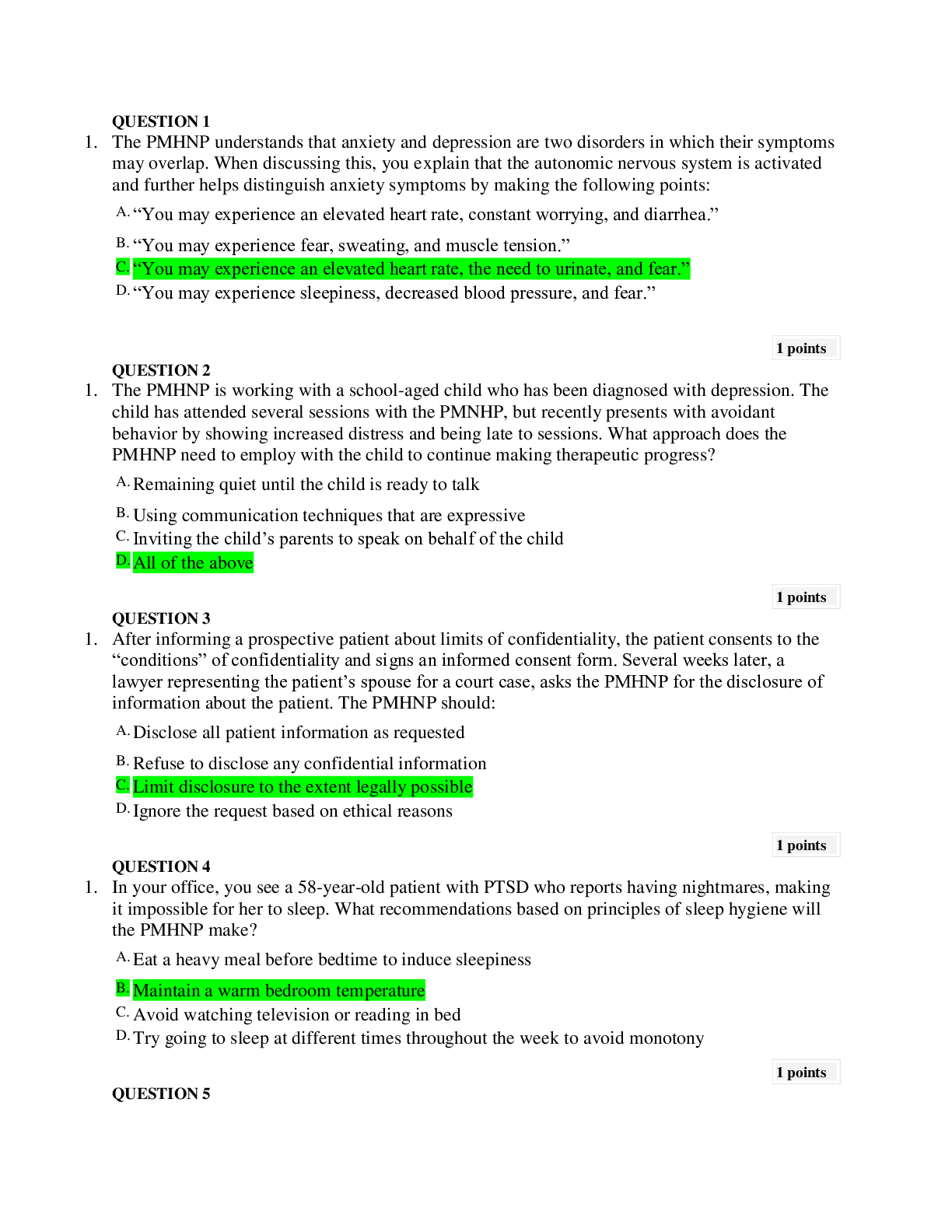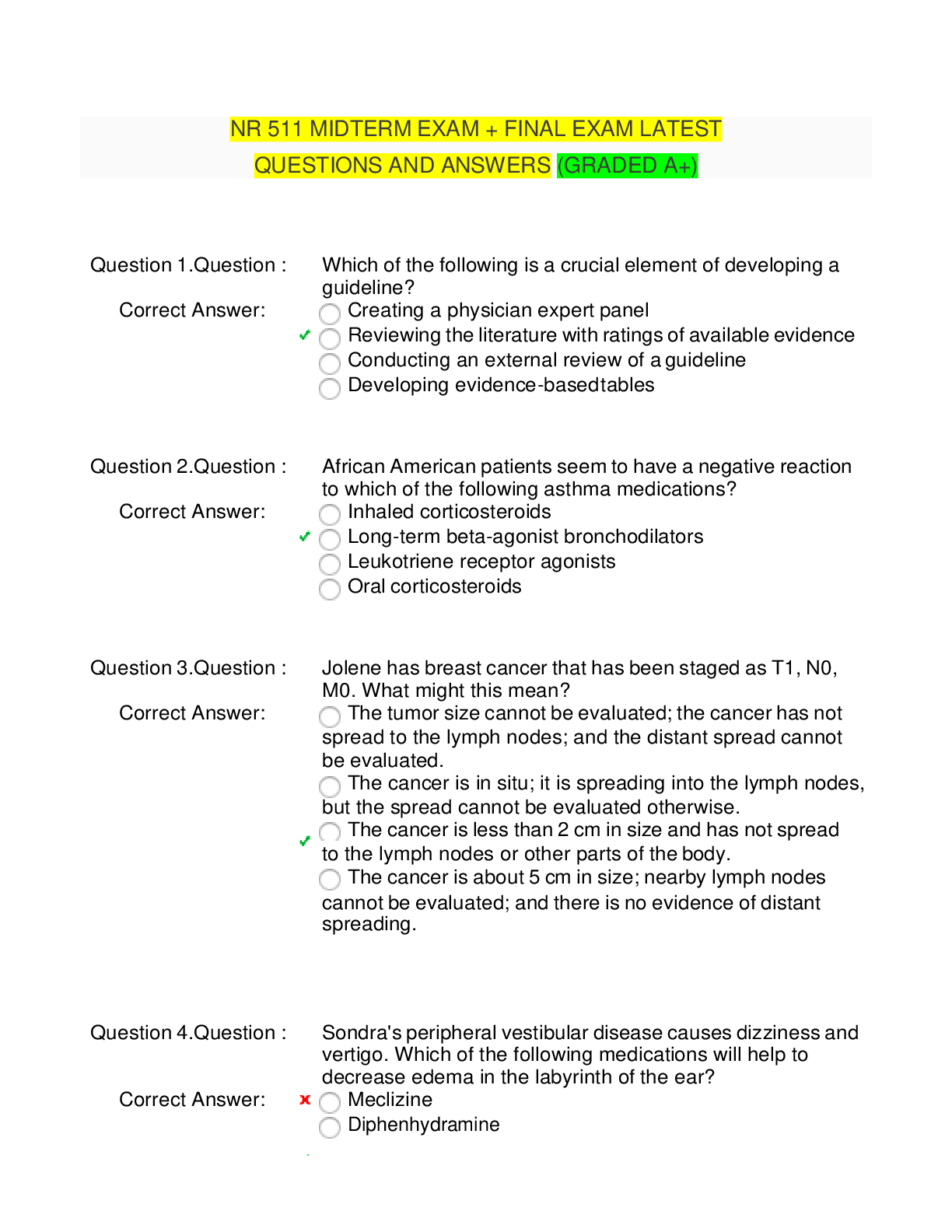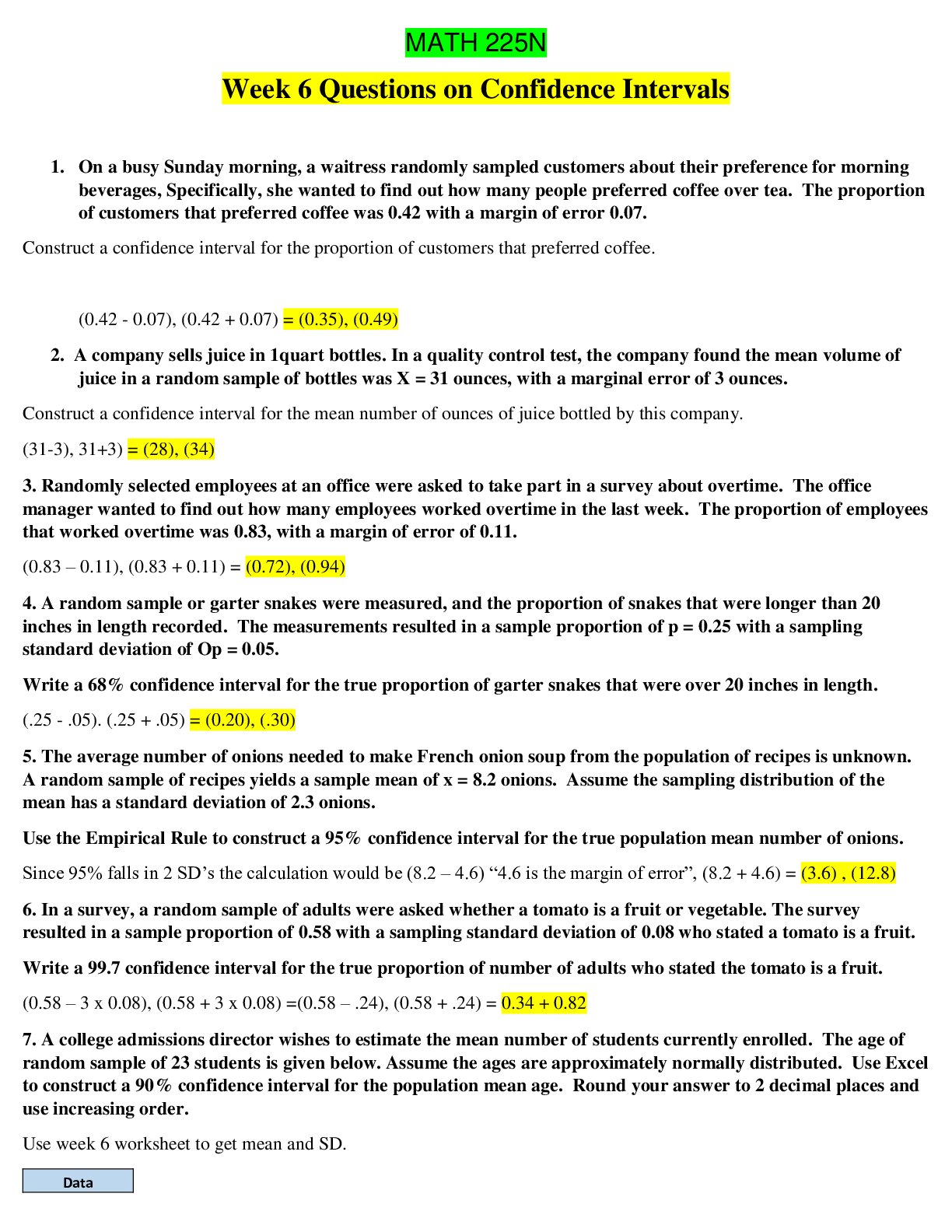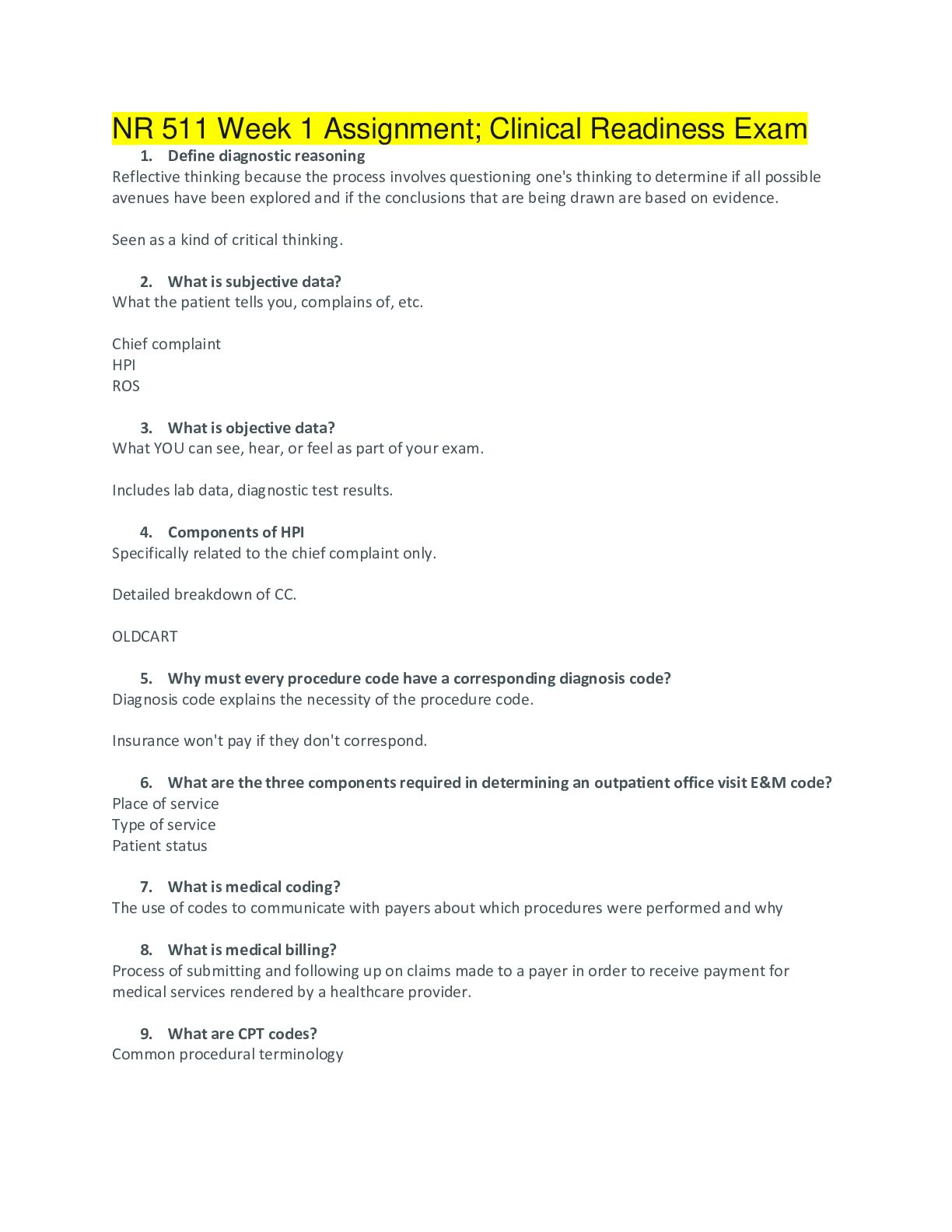English Language > EXAM > CALT Exam questions and Answers 2022/2023,100% CORRECT (All)
CALT Exam questions and Answers 2022/2023,100% CORRECT
Document Content and Description Below
CALT Exam questions and Answers 2022/2023 coarticulation - Correct Answerthe ability to overlap several phonemes anaphora - Correct Answerpronouns or articles used to refer to something alread... y mentioned appositive - Correct Answera noun or noun phrase placed after a noun to describe it more fully model involves two-way connection between context and meaning, and two way connections between orthography and phonology - Correct AnswerRumelhart and Seidenberg's Connectionist Theory meaning based and code-based strategies are taught together. First order skill are enciphering and deciphering. Second order skills are comprehension/composition. 1st and 2nd order skills are taught together - Correct AnswerFarnham-Diggory Model trade-off of sub processes. Readers with poor word recognition are more reliant on context than good readers. Skill of reading as a developing process - Correct AnswerStanovich's Interactive-Compensatory Model 1. Letters are connected with phonemes. 2. Units of letters are connected with parts of spoken speech. 3. Printed word is connected to its meaning. Cipher Sight Reading (words are recognized quickly through Cipher strategy) - Correct AnswerEhri contributions 1. Alphabetic spelling precedes alphabetic reading 2. Dyslexics begin to fall behind in "Alphabetic Phase" - Correct AnswerFirth's contributions 1. 1930 (John Dewey) whole word teaching 2. 1960-1970 Language-experience text 3. Chall (1983) direct phonics instruction more successful 4. Adams-importance of connections between meaning "processors" and letter-sound "processors", effective phonics instruction must be linked with language based reading instruction - Correct AnswerThe Great Debate: Phonics vs. Whole Language 1. The Logographic Phase 2. The Phonetic-Cue Phase (Early Alphabetic) 3. The Cipher or Alphabetic Phase (Mature Alphabetic) 4. The Orthographic Phase - Correct AnswerEhri's Four Phases of Reading Strategy Development (Phases of Word Learning) Uta Firth-visual cue phase Pre-phonics lexicon-example (McD sign) many argue this stage does not exist - Correct AnswerThe Logographic Phase (Ehri) Linnea Ehri-Rudimentary alphabetic phase recall similar letters in words pre-alphabetic principle phase - Correct AnswerThe Phonetic-Cue Phase (Early Alphabetic) (Ehri) Early sight word meaning Phoneme-Grapheme correspondence Left to right sounding out letters Complete phoneme awareness Alphabetic principle Accuracy - Correct AnswerThe Cipher or Alphabetic Phase (Mature Alphabetic) (Ehri) Reading fluency by sound, syllable morphemes Whole words. Orthography in Greek means "perfect writing" Refers to spelling patterns Onset-rime use in spelling - Correct AnswerThe Orthographic Phase (Ehri) 1. Imitation 2. Graphic Presentation 3. Progressive Incorporation 4. Automatization 5. Elaboration Personalization-Diversification - Correct AnswerMel Levine's Developmental Stages of Learning Handwriting preschool-1st mimicking of actual writing motor problems may indicate at risk hand preference not fully established - Correct AnswerImitation (Mel Levine) 1st-2nd directionality and laterality reliance on proprioception - Correct AnswerGraphic Presentation (Mel Levine) 2nd-4th aesthetic production cursive writing - Correct AnswerProgressive Incorporation (Mel Levine) 4th-7th Increased writing rate and efficiency grammar usage - Correct AnswerAutomatization (Mel Levine) 7th-9th writing to establish viewpoint - Correct AnswerElaboration (Mel Levine) 9th-above Individual style and talent - Correct AnswerPersonalization-Diversification (Mel Levine) 1. words in sentence 2. syllables in words 3. phonemes in single words phonemic awareness - Correct AnswerLiberman developmental hierarchy % of 4th graders that are not fluent - Correct Answer44% (NAEP) acquired disorder in which ability to form letter shapes, letter sequences and motor patterns is impaired - Correct Answerspecific agraphia motor feedback problem, fingers do not report location back to the brain - Correct Answerfinger agnosia refers to the singular musical qualities of language, including intonation, expression, accent, pitch, juncture and rhythm - Correct Answersuprasegmental Dysrhthmic (when repeating syllables) - Correct AnswerPeter Wolff poor word find ability - Correct Answeranomia spoken language is innate - Correct AnswerChomsky writing is not language. It is a way of recording language through visible sounds - Correct AnswerBloomfield particulate principle of self-diversifying system-phonemes are like DNA strands, you can create almost infinite number of possible combinations - Correct AnswerAbler (1889) ADD/ADHD was known as ______ in 1960s-70s - Correct Answerminimal brain dysfunction difficulty remembering visual aspects of words (visual memory deficit) - Correct Answerdyseidic poor readers are more likely to apply a visual-orthographic strategy in reading and a phonological strategy to spelling - Correct AnswerBarron once critical levels achieved, variation in comprehension may be due to strengths in vocabulary, general knowledge - Correct AnswerBruck's minimal threshold level physician responsible for modern concept of brain localization of cognitive functions - Correct AnswerFranz Gall what physician examined the post mortem brain affected by aphasia and discovered an irregular lesion in the left frontal region - Correct AnswerPaul Broca (1861) loss of fluency speech while retaining the ability to understand language - Correct Answerbroca aphasia could retain ability to swear - Correct Answerexpressive aphasia discovered that roots of reading originate in the cerebral cortex - Correct AnswerPaul Broca current research supports this model for qualifying for sped. - Correct Answerprofile model NOT discrepancy model precursor to modern ideas about localization of brain functions - Correct AnswerPhrenology whose theory was that dyslexia resulted from damage during fetal development - Correct AnswerNorman Geschwind Professor at Syracruse Done great deal of research in field of phonology/reading - Correct AnswerBonita Blachman Columbia University responsible for structure language trainning Author of Multisensory Teaching of Basic Language Skills - Correct AnswerJudith Birsh "The Roots of Phonics", an important historical introduction to phonics with a foreword by Jeanne Chall - Correct AnswerMiriam Balmuth Texas dyslexia definition is - Correct AnswerExclusionary NIH/IDA dyslexia definition is - Correct AnswerInclusionary Where did language start - Correct Answerprehistoric times, started near the border between Europe and Asia Effects of Germanic Tribes - Correct Answermarried, enslaved or drove out the Celts Norse words were brought into the language - Correct AnswerViking Invasions 800 CE Names for 6 days of the week comes from - Correct AnswerOld English words Language of the church Language of the judicial system Language of commoners Spoken orally-when written, the writer created the spelling - Correct AnswerMiddle English (1066-1500) How were plurals formed in Middle English - Correct Answeradding -s or -es instead of changing the vowel man/men, mouse/mice -eth changed to -s (doeth/does, goeth/goes) during - Correct AnswerMiddle English -en became -s (shoen/shoes) during - Correct AnswerMiddle English Printing press The Great Vowel shift Started the beginning of _______ - Correct AnswerStandard English Took place slowly over 200 years vowel sounds pronounced in new positions and created a distinct separation between phonology and spelling - Correct AnswerThe Great Vowel Shift textbooks after 4th grade have a lot of this language - Correct AnswerLatin This time period was the 3rd and most important introduction of Latin into English - Correct AnswerRenaissance Latin roots are ____morphemes - Correct AnswerBound morphemes Greek morphemes are ___ words (microscope) - Correct Answercompound words Master's English caused _____ to be added to English - Correct Answerthe letter r [Show More]
Last updated: 1 year ago
Preview 1 out of 7 pages
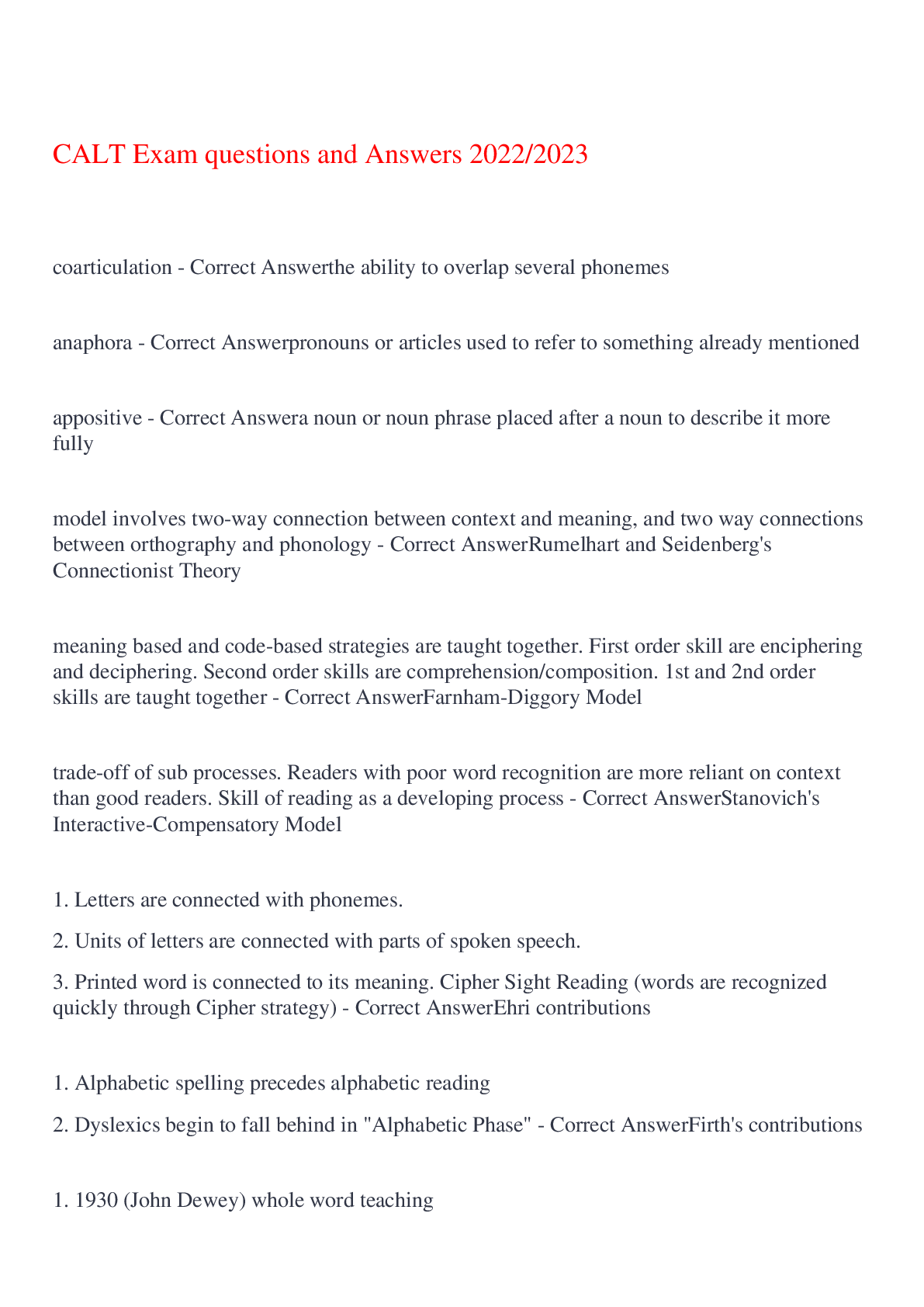
Buy this document to get the full access instantly
Instant Download Access after purchase
Add to cartInstant download
We Accept:

Reviews( 0 )
$7.00
Document information
Connected school, study & course
About the document
Uploaded On
Feb 10, 2023
Number of pages
7
Written in
Additional information
This document has been written for:
Uploaded
Feb 10, 2023
Downloads
0
Views
59














